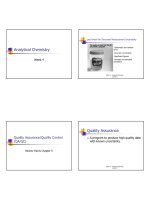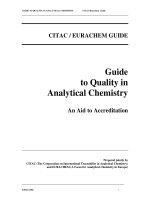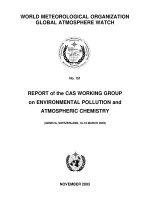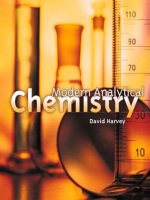ANALYTICAL CHEMISTRY docx
Bạn đang xem bản rút gọn của tài liệu. Xem và tải ngay bản đầy đủ của tài liệu tại đây (577.09 KB, 61 trang )
Welcome to Chem 321
A key course to your future success
ANALYTICAL CHEMISTRY
COURSE OUTLINE
Instructor: Dr. X. Nancy Xu
Office: Alfriend Chemistry Building Room 201
Office Hours: MW 7:10-8:00 PM (OCNPS 200)
Right after the class
Teaching Assistant: Dr. Tao Huang and Jill Lowman
Email:
MW 5:45 – 7:00 PM
OCNPS Room 200
Class Time & Place
¾MATH 102 or equivalent
¾CHEM 115, 116.
Pre-requisites
Textbook
Quantitative Chemical Analysis, 7
th
edition, D. Harris, Freeman, 2007.
Reference Book
Fundamentals of Analytical Chemistry, 7th Ed.
Skoog/West/Holler, Saunders Publishing, 1996
One copy of the book is placed in the reserved desk of the library.
About Textbook
¾Preface
¾Chapter 1-16 (Chem 321)
¾Summary
¾Questions and Problems
¾Answers to the problems: in the reserved desk in
the library
¾Glossary G-1… on the back of the book
¾ Chapters heavily associated with Chem 322
Course Website
• Class notes, assigned problems and announcements
are posted at
/> />em321.htm
• Visit this site as frequently as possible, especially
before and after every class
• You will need Acrobat Reader to download large
documents
Honor Code
• Students registered for CHEM 321 are
expected to obey the ODU Honor Code!!!
Attendance
¾Attendance at class meeting is compulsory.
¾Regular and punctual class attendance is
required of all students.
¾If you are absent, you will be responsible for
everything covered in class including any
handouts (e.g., problem sets, answers, sample
tests, etc).
Absence from Exams
¾Missed exams may be made up only with a
medical excuse (written by physician or health
center), death or hospitalization in the family.
¾Without these reasons, one will earn a “zero”
grade on that test.
¾No exceptions will be made
. Please contact me
prior to the exam if you must be absent.
Homework
¾ Assigned homework is mandatory.
¾ Working on these assignments in a timely manner is the
best way to learn the material and get good grades.
¾ I may check your assignments and sample your
homework on the due date even though it may not be
graded.
¾ The brief answers to assigned problems are available in
the solution book, which is placed in the reserved desk in
the library .
Exams
• 4 unit tests and a comprehensive
final examination
Grading
• Average cumulated grade = unit tests
(70%) and final exam (30%)
¾100-93 = A 92-90 = A
-
¾89-87 = B
+
86-83 = B 82-80 = B
-
¾79-77 = C
+
76-73 = C 72-70 = C
-
¾69-67 = D
+
66-63 = D 62-60 = D
-
¾<60 = F
Tentative Timeline
Date Chapter Topic Homework
01/08 1 Measurement 1-12, 17, 22, 28, 31, 32, 34
01/10 3 Experimental Error 3-1, 2, 5, 10, 12, 13, 15, 16, 22
01/15 Martin Luther King Holiday- No classes
01/17, 22 4 Statistics 4-A, E, F, 11, 14, 17, 20
01/24
1st Unit Test (Chapter 1, 3, 4)
01/29, 31 6 Chemical Equilibrium 6-4, 15, 16, 19, 22, 25, 30, 37, 47, 48, 53
02/5, 7 7 Let the Titrations Begin 7-B, F, 7, 22, 23, 28, 36
02/12, 14,
19
8 Activities and Systematic Treatment
of Equilibrium
8-A, B, C, E, F, G, 2, 4, 11, 12, 18, 20,
24, 26
02/21 9, 11 Monoprotic Acid-Base Equilibrium 9-B, D, E, 2, 5, 6, 22, 23, 27, 28, 33
02/26 6-9 Recitation and help session
02/28 2nd Unit Test (Chapter 6-9)
03/05-10 Spring Break- No classes
03/12, 14 10, 11 Polyprotic acid-Base Equilibrium 10-A, B, D, 4, 11, 17, 18, 23
03/19, 23 11 Acid-Base Titration 11-A, B, F, 3, 6, 14, 19, 23
03/26,28 12 EDTA Titration 12-C, D, 1, 2, 3, 7, 8, 24, 34
04/02 3rd Unit Test (Chapter 10-12)
04/04, 09 14 Fundamentals of Electrochemistry 14-B, C, D, 2, 10, 25
04/11,16 15 Electrodes and Potentiometry 15-4, 8, 9, 21, 26
04/18 16 Redox Titration 16-A, 1, 2, 6, 13
04/23
4th Unit Test (Chapter 14-16)
04/30 3:45-6:45 PM
Comprehensive Final Examination (Chapter 1-16, except 2, 5 and 13)
Note to the class
• Welcome to Chem 321, a key course to your future
success in analytical data analysis and experimental
design of any chemical related problems in every
scientific disciplinary including chemistry, biology,
biotechnology, forensic science, food science, material
science, medicine, environmental science, etc.
• Whether you aim to be a brilliant scientist, a medical
doctoral, a technician or a good cook, you will find this
course essential and helpful for your future career.
What are we going to do in the class ??
• We will introduce basic analytical concepts
and theories and focus on data analysis and
interpretation.
Six tips for success in this class
• actively attending every class and take good
notes
• improving your math (good math is absolutely
essential)
• completing all homework and study textbook,
class notes and slides
• asking questions
• coming to Dr. Xu’s office hours
• visiting course website frequently.
Good-luck to you!!
Dr. Nancy Xu
Chapter 1: Introduction & Measurements
What is Analytical Chemistry?
“Analytical Chemistry is what analytical
chemists do.”
C. N. Reilley
Roles of Analytical Chemistry
¾ Play a vital roles in all sciences, just to name of a few:
chemistry, biology, biotechnology, forensic science,
food science, material science, medicine,
environmental science, etc.
¾ Examples of achievement of Analytical chemistry:
¾ Breakthrough of the century: Sequence of Human
Genome, Analytical chemists-capillary
electrophoresis.
Classification of Analysis
¾ Qualitative Analysis
determination of chemical identity of the species in the
sample.
¾ Quantitative Analysis
determination of the amount of species or analytes, in
numerical terms. Hence, Math is heavily involved.
9 In order to perform quantitative analysis, typically
one needs to complete qualitative analysis.
9 One needs to know what it is and then select the
means to determine the amount
Classification of Quantitative
Methods of Analysis
¾ Gravimetric Method: mass is measured.
¾ Volumetric Method: volume is measured or used
to determine amount of sample via concentration.
¾ Instrumental Method: use an instrumental
technique to assay the amount of sample:
¾ Such as: Electroanalytical based upon electron-transfer
Spectroscopy including mass spectrometry
(***hot) (proteomic)
Steps in a Typical Quantitative Analysis









